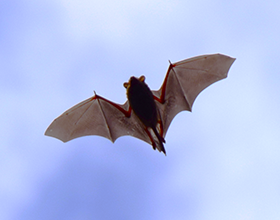 Bats in the Beech Tree
Bats in the Beech Tree
With the arrival of April, lots of animal migrants are returning north to Ohio from their wintering grounds. In the tops of sycamore trees, yellow-throated warblers sing and flash their colors. Out in the wetlands, green darner dragonflies skim the water’s surface and deposit their eggs. And in the woods, hanging like fruits among the remnant leaves of understory beech trees, red bats wait to fly out after unsuspecting moths.
Eastern red bats, Lasiurus borealis, are one of more than a half-dozen species of “vesper bats”— small bats in the family Vespertillionidae — that inhabit Greene and Montgomery Counties. As their name suggests, red bats are almost uniformly a lovely chestnut color, other than small white patches on the shoulders. The genus name Lasiurus means “hairy tail”, which describes another characteristic feature, though one that’s not so easy to see.
With wings that span about 12 inches (30 cm) from tip to tip, red bats look rather large in flight. But really, they are mid-sized among Ohio’s vesper bats and weigh in at about 10 grams, just half of a house mouse. At that small size, winter poses a challenge for red bats. To function normally, they need to keep their bodies warm (bats maintain body temperatures similar to humans). Yet food (insects) is not available during cold weather, and the bats are susceptible to rapid cooling. Red bats meet that challenge using two strategies.
The primary strategy for surviving winter’s cold is to avoid it; red bats migrate south for winter. Two features of small bats allow that strategy to work. The most obvious is that they can fly. Red bats have been clocked at 40 miles per hour in level flight and so, unlike a similar sized rodent, they can realistically cover the distances between northern and southern US on a seasonal time scale. In addition, bats are long-lived relative to most small mammals. Some vesper bats have lived for 20 years or more, ten times as long as a like-sized mouse. (There seem not to be good records of lifespan for wild red bats.) Again, that means that seasonal movement between breeding and wintering sites is a realistic strategy. So, red bats mostly spend the winter in the southeastern US and northern Mexico, then fly north to the upper half of eastern US and southern Canada for the warmer months. They arrive in Ohio by March or April.
Even with that migration, red bats can encounter spells of cold weather. Their springtime local arrival occurs well before days become reliably warm. And so those cold nights are when red bats employ their second survival strategy. That is, they hibernate. Red bats are solitary animals and they roost in trees, so hibernation looks a bit different than the usual picture of dormant bats clustered in a cave. Instead, red bats curl up in a protected tree hollow, or sometimes bury into the leaf litter on the forest floor. There, they allow body temperature to drop to right near ambient temperature–as low as about 3oC, not far above freezing. That low body temperature reduces the rate of metabolism by more than 95% and allows them to get by using stored fat, without needing to eat.
When red bats do eat, their preferred food is moths. A study that used DNA sequencing to examine dietary leftovers in the feces of red bats identified more than 125 species of insects. Most of those were moths, including a number of species that are considered pests by humans, like gypsy moths, tent caterpillar moths, cutworm moths, and others. Notably missing from the diet were tiger moths and their relatives (moths in the group Arctiinae). Those moths have auditory systems and flight behaviors that facilitate bat detection and avoidance, and those systems seem to be effective against predation by red bats.
Red bats mostly feed at night, but they do sometimes fly in daylight. For the females, that “extra” feeding might support their reproductive efforts. Red bats have delayed fertilization: they actually mate in the fall, then the females store the sperm overwinter until the eggs are fertilized in spring. Females raise their young—typically twins—through the summer, so they need to feed voraciously for those months. Although red bats have been known to congregate into small groups while migrating, they typically are seen singly during their spring and summer residence.
Red bats roost in deciduous trees, where they hang from small branches by one or both feet. In summer, preferred roosting sites are under dense leaf cover, which provides protection from overhead predation (crows, blue jays, and owls are among their predators) but allows easy downward departure. Sycamores, oaks, elms, and box elders are commonly selected. But in April, before those species leaf out, red bats often roost among the dead, papery leaves that remain from last year on smaller beech trees. The color of the bats camouflages perfectly among those orange-brown leaves. Cities might have bats in the belfry—but out here in the parks, look out for bats in the beech trees instead!
Article and photo contributed by Dr. David L. Goldstein, Emeritus Professor, Department of Biological Sciences, Wright State University.
